A New Family of Macrocyclic Polyamino Biphenolic Ligands: Acid-Base Study, Zn(II) Coordination and Glyphosate/AMPA Binding
Abstract
1. Introduction
2. Results and Discussion
2.1. Synthesis
2.2. Protonation and Zn(II) Binding by L1 and L2
2.2.1. Basicity of L1 and L2
2.2.2. Coordination of Zn(II) by L1 and L2
2.3. PMG and AMPA Binding by Zn(II) Complexes of L1 and L2
2.3.1. Potentiometric Measurements
2.3.2. Fluorescence Measurements
3. Conclusions
4. Materials and Methods
4.1. Synthesis
4.1.1. 23,24-Dimethoxy-3,6,9,12-tetrakis(4-methylbenzenesufonyl)-3,6,9,12-tetraazatricyclo[17.3.1.1(14,18)]eicosatetra-1(23),14,16,18(24),19,21-hexaene (4)
4.1.2. 23,24-Dihydroxy-3,6,9,12-tetraazatricyclo[17.3.1.1(14,18)]eicosatetra-1(23),14,16,18(24),19,21-hexaene Tetrahydrochloride (L1·4HCl)
4.1.3. 26,27-Dimethoxy-3,6,9,12,15-pentakis(4-methylbenzenesufonyl)-3,6,9,12,15-pentaazatricyclo[20.3.1.1(17,21)]eicosaepta-1(26),17,19,21(27),22,24-hexaene (5)
4.1.4. 26,27-Dihidroxy-3,6,9,12,15-pentaazatricyclo[20.3.1.1(17,21)]eicosaepta-1(26),17,19,21(27),22,24-hexaenepentahidrochloride (L2·5HCl)
4.2. Potentiometric Measurements
4.3. Spectrophotometric and Fluorescence Measurements
Supplementary Materials
Author Contributions
Funding
Institutional Review Board Statement
Informed Consent Statement
Data Availability Statement
Acknowledgments
Conflicts of Interest
References
- Maggi, F.; la Cecilia, D.; Tang, F.H.M.; McBratney, A. The global environmental hazard of glyphosate use. Sci. Total Environ. 2020, 717, 137167. [Google Scholar] [CrossRef] [PubMed]
- Richmond, M.E. Glyphosate: A review of its global use, environmental impact, and potential health effects on humans and other species. J. Environ. Stud. Sci. 2018, 8, 416–434. [Google Scholar] [CrossRef]
- Gravena, R.; Filho, R.V.; Alves, P.L.C.A.; Mazzafera, P.; Gravena, A.R. Glyphosate has low toxicity to citrus plants growing in the field. Can. J. Plant Sci. 2012, 92, 119–127. [Google Scholar] [CrossRef]
- Duke, S.O.; Powles, S.B. Glyphosate: A once-in-a-century herbicide. Pest Manag. Sci. 2008, 64, 319–325. [Google Scholar] [CrossRef]
- Benbrook, C.M. Trends in glyphosate herbicide use in the United States and globally. Environ. Sci. Eur. 2016, 28, 3. [Google Scholar] [CrossRef]
- Kanissery, R.; Gairhe, B.; Kadyampakeni, D.; Batuman, O.; Alferez, F. Glyphosate: Its Environmental Persistence and Impact on Crop Health and Nutrition. Plants 2019, 8, 499. [Google Scholar] [CrossRef] [PubMed]
- Hendlin, Y.H.; Arcuri, A.; Lepenies, R.; Hüesker, F. Like Oil and Water: The Politics of (Not) Assessing Glyphosate Concentrations in Aquatic Ecosystems. Eur. J. Risk Regul. 2020, 11, 539–564. [Google Scholar] [CrossRef]
- Soares, D.; Silva, L.; Duarte, S.; Pena, A.; Pereira, A. Glyphosate Use, Toxicity and Occurrence in Food. Foods 2021, 10, 2785. [Google Scholar] [CrossRef] [PubMed]
- Benbrook, C.M. How did the US EPA and IARC reach diametrically opposed conclusions on the genotoxicity of glyphosate-based herbicides? Environ. Sci. Eur. 2019, 31, 2. [Google Scholar] [CrossRef]
- Meftaul, I.M.; Venkateswarlu, K.; Dharmarajan, R.; Annamalai, P.; Asaduzzaman, M.; Parven, A.; Megharaj, M. Controversies over human health and ecological impacts of glyphosate: Is it to be banned in modern agriculture? Environ. Pollut. 2020, 263, 114372. [Google Scholar] [CrossRef]
- IARC, W. Evaluation of Five Organophosphate Insecticides and Herbicides; IARC: Lyon, France, 2015.
- Van Bruggen, A.H.C.; He, M.M.; Shin, K.; Mai, V.; Jeong, K.C.; Finckh, M.R.; Morris, J.G. Environmental and health effects of the herbicide glyphosate. Sci. Total Environ. 2018, 616–617, 255–268. [Google Scholar] [CrossRef]
- Tóth, G.; Háhn, J.; Radó, J.; Szalai, D.A.; Kriszt, B.; Szoboszlay, S. Cytotoxicity and hormonal activity of glyphosate-based herbicides. Environ. Pollut. 2020, 265, 115027. [Google Scholar] [CrossRef]
- Del Castilo, I.; Neumann, A.S.; Lemos, F.S.; De Bastiani, M.A.; Oliveira, F.L.; Zimmer, E.R.; Rêgo, A.M.; Hardoim, C.C.P.; Antunes, L.C.M.; Lara, F.A.; et al. Lifelong Exposure to a Low-Dose of the Glyphosate-Based Herbicide RoundUp® Causes Intestinal Damage, Gut Dysbiosis, and Behavioral Changes in Mice. Int. J. Mol. Sci. 2022, 23, 5583. [Google Scholar] [CrossRef]
- Peillex, C.; Pelletier, M. The impact and toxicity of glyphosate and glyphosate-based herbicides on health and immunity. J. Immunotoxicol. 2020, 17, 163–174. [Google Scholar] [CrossRef] [PubMed]
- Carretta, L.; Masin, R.; Zanin, G. Review of studies analysing glyphosate and aminomethylphosphonic acid (AMPA) occurrence in groundwater. Environ. Rev. 2022, 30, 88–109. [Google Scholar] [CrossRef]
- Reynoso, E.; Torres, E.; Bettazzi, F.; Palchetti, I. Trends and Perspectives in Immunosensors for Determination of Currently-Used Pesticides: The Case of Glyphosate, Organophosphates, and Neonicotinoids. Biosensors 2019, 9, 20. [Google Scholar] [CrossRef]
- Butmee, P.; Tumcharern, G.; Songsiriritthigul, C.; Durand, M.J.; Thouand, G.; Kerr, M.; Kalcher, K.; Samphao, A. Enzymatic electrochemical biosensor for glyphosate detection based on acid phosphatase inhibition. Anal. Bioanal. Chem. 2021, 413, 5859–5869. [Google Scholar] [CrossRef] [PubMed]
- Mikac, L.; Rigó, I.; Škrabić, M.; Ivanda, M.; Veres, M. Comparison of Glyphosate Detection by Surface-Enhanced Raman Spectroscopy Using Gold and Silver Nanoparticles at Different Laser Excitations. Molecules 2022, 27, 5767. [Google Scholar] [CrossRef]
- Liu, Q.; Zhang, R.; Yu, B.; Liang, A.; Jiang, Z. A highly sensitive gold nanosol SERS aptamer assay for glyphosate with a new COF nanocatalytic reaction of glycol-Au(III). Sens. Actuators B Chem. 2021, 344, 130288. [Google Scholar] [CrossRef]
- Zhang, Y.; Dang, Y.; Lin, X.; An, K.; Li, J.; Zhang, M. Determination of glyphosate and glufosinate in corn using multi-walled carbon nanotubes followed by ultra high performance liquid chromatography coupled with tandem mass spectrometry. J. Chromatogr. A 2020, 1619, 460939. [Google Scholar] [CrossRef]
- Ulrich, J.C.; Ferguson, P.L. Development of a sensitive direct injection LC-MS/MS method for the detection of glyphosate and aminomethylphosphonic acid (AMPA) in hard waters. Anal. Bioanal. Chem. 2021, 413, 3763–3774. [Google Scholar] [CrossRef]
- Pires, N.L.; Passos, C.J.S.; Morgado, M.G.A.; Mello, D.C.; Infante, C.M.C.; Caldas, E.D. Determination of glyphosate, AMPA and glufosinate by high performance liquid chromatography with fluorescence detection in waters of the Santarém Plateau, Brazilian Amazon. J. Environ. Sci. Health Part B 2020, 55, 794–802. [Google Scholar] [CrossRef] [PubMed]
- Stalikas, C.D.; Pilidis, G.A. Development of a method for the simultaneous determination of phosphoric and amino acid group containing pesticides by gas chromatography with mass-selective detection. J. Chromatogr. A 2000, 872, 215–225. [Google Scholar] [CrossRef] [PubMed]
- Arkan, T.; Molnár-Perl, I. The role of derivatization techniques in the analysis of glyphosate and aminomethyl-phosphonic acid by chromatography. Microchem. J. 2015, 121, 99–106. [Google Scholar] [CrossRef]
- Li, Z.-M.; Kannan, K. A Method for the Analysis of Glyphosate, Aminomethylphosphonic Acid, and Glufosinate in Human Urine Using Liquid Chromatography-Tandem Mass Spectrometry. Int. J. Environ. Res. Public Health 2022, 19, 4966. [Google Scholar] [CrossRef] [PubMed]
- Huhn, C. More and enhanced glyphosate analysis is needed. Anal. Bioanal. Chem. 2018, 410, 3041–3045. [Google Scholar] [CrossRef] [PubMed]
- McNaughton, D.A.; Fares, M.; Picci, G.; Gale, P.A.; Caltagirone, C. Advances in fluorescent and colorimetric sensors for anionic species. Coord. Chem. Rev. 2021, 427, 213573. [Google Scholar] [CrossRef]
- Zhao, J.; Yang, D.; Yang, X.J.; Wu, B. Anion coordination chemistry: From recognition to supramolecular assembly. Coord. Chem. Rev. 2019, 378, 415–444. [Google Scholar] [CrossRef]
- Verdejo, B.; Inclán, M.; Clares, M.P.; Bonastre-Sabater, I.; Ruiz-Gasent, M.; García-España, E. Fluorescent Chemosensors Based on Polyamine Ligands: A Review. Chemosensors 2021, 10, 1. [Google Scholar] [CrossRef]
- Bartoli, F.; Bencini, A.; Conti, L.; Giorgi, C.; Valtancoli, B.; Paoli, P.; Rossi, P.; Le Bris, N.; Tripier, R. Catching anions with coloured assemblies: Binding of pH indicators by a giant-size polyammonium macrocycle for anion naked-eye recognition. Org. Biomol. Chem. 2016, 14, 8309–8321. [Google Scholar] [CrossRef]
- Bettazzi, F.; Voccia, D.; Bencini, A.; Giorgi, C.; Palchetti, I.; Valtancoli, B.; Conti, L. Optical and Electrochemical Study of Acridine-Based Polyaza Ligands for Anion Sensing. Eur. J. Inorg. Chem. 2018, 2018, 2675–2679. [Google Scholar] [CrossRef]
- Garau, A.; Bencini, A.; Blake, A.J.; Caltagirone, C.; Conti, L.; Isaia, F.; Lippolis, V.; Montis, R.; Mariani, P.; Scorciapino, M.A. [9]aneN 3 -based fluorescent receptors for metal ion sensing, featuring urea and amide functional groups. Dalt. Trans. 2019, 48, 4949–4960. [Google Scholar] [CrossRef]
- Conti, L.; Giorgi, C.; Valtancoli, B.; Paoli, P.; Rossi, P.; Marchionni, A.; Faggi, E.; Bencini, A. Switching on the Fluorescence Emission of Polypyridine Ligands by Simultaneous Zinc(II) Binding and Protonation. Chempluschem 2020, 85, 659–671. [Google Scholar] [CrossRef] [PubMed]
- Garau, A.; Lvova, L.; Macedi, E.; Ambrosi, G.; Aragoni, M.C.; Arca, M.; Caltagirone, C.; Coles, S.J.; Formica, M.; Fusi, V.; et al. N2S2pyridinophane-based fluorescent chemosensors for selective optical detection of Cd2+ in soils. New J. Chem. 2020, 44, 20834–20852. [Google Scholar] [CrossRef]
- Paderni, D.; Giorgi, L.; Voccia, M.; Formica, M.; Caporaso, L.; Macedi, E.; Fusi, V. A New Benzoxazole-Based Fluorescent Macrocyclic Chemosensor for Optical Detection of Zn2+ and Cd2+. Chemosensors 2022, 10, 188. [Google Scholar] [CrossRef]
- Ambrosi, G.; Formica, M.; Fusi, V.; Giorgi, L.; Macedi, E.; Micheloni, M.; Pontellini, R. Synthesis of new compartmental amino-phenolic ligands. Basicity, coordination properties towards Cu(II) and Zn(II) ions. A fluorescent chemosensor for H+ and Zn(II). Inorganica Chim. Acta 2009, 362, 2667–2677. [Google Scholar] [CrossRef]
- Amatori, S.; Ambrosi, G.; Borgogelli, E.; Fanelli, M.; Formica, M.; Fusi, V.; Giorgi, L.; Macedi, E.; Micheloni, M.; Paoli, P.; et al. Modulating the sensor response to halide using NBD-based azamacrocycles. Inorg. Chem. 2014, 53, 4560–4569. [Google Scholar] [CrossRef]
- Ambrosi, G.; Formica, M.; Fusi, V.; Giorgi, L.; Guerri, A.; Macedi, E.; Micheloni, M.; Paoli, P.; Pontellini, R.; Rossi, P. Phosphates sensing: Two polyamino-phenolic zinc receptors able to discriminate and signal phosphates in water. Inorg. Chem. 2009, 48, 5901–5912. [Google Scholar] [CrossRef]
- Bazany-Rodríguez, I.J.; Salomón-Flores, M.K.; Bautista-Renedo, J.M.; González-Rivas, N.; Dorazco-González, A. Chemosensing of Guanosine Triphosphate Based on a Fluorescent Dinuclear Zn(II)-Dipicolylamine Complex in Water. Inorg. Chem. 2020, 59, 7739–7751. [Google Scholar] [CrossRef] [PubMed]
- Anbu, S.; Paul, A.; Stasiuk, G.J.; Pombeiro, A.J.L. Recent developments in molecular sensor designs for inorganic pyrophosphate detection and biological imaging. Coord. Chem. Rev. 2021, 431, 213744. [Google Scholar] [CrossRef]
- Ramakrishnam Raju, M.V.; Harris, S.M.; Pierre, V.C. Design and applications of metal-based molecular receptors and probes for inorganic phosphate. Chem. Soc. Rev. 2020, 49, 1090–1108. [Google Scholar] [CrossRef] [PubMed]
- Ambrosi, G.; Formica, M.; Fusi, V.; Giorgi, L.; Macedi, E.; Micheloni, M.; Pontellini, R. A family of polyamino phenolic macrocyclic ligands. Acid-base and coordination properties towards Co(II), Ni(II), Cu(II), Zn(II), Cd(II) and Pb(II) ions. Inorganica Chim. Acta 2009, 362, 3709–3714. [Google Scholar] [CrossRef]
- Ambrosi, G.; Formica, M.; Fusi, V.; Giorgi, L.; Macedi, E.; Micheloni, M.; Paoli, P.; Rossi, P. A Biphenol-Based Chemosensor for ZnII and CdII Metal Ions: Synthesis, Potentiometric Studies, and Crystal Structures. Inorg. Chem. 2016, 55, 7676–7687. [Google Scholar] [CrossRef]
- Ambrosi, G.; Battelli, C.; Formica, M.; Fusi, V.; Giorgi, L.; Macedi, E.; Micheloni, M.; Pontellini, R.; Prodi, L. Two polyaminophenolic fluorescent chemosensors for H + and Zn(II). Spectroscopic behaviour of free ligands and of their dinuclear Zn(II) complexes. New J. Chem. 2009, 33, 171–180. [Google Scholar] [CrossRef]
- Ambrosi, G.; Formica, M.; Fusi, V.; Giorgi, L.; Micheloni, M. Polynuclear metal complexes of ligands containing phenolic units. Coord. Chem. Rev. 2008, 252, 1121–1152. [Google Scholar] [CrossRef]
- Ambrosi, G.; Formica, M.; Fusi, V.; Giorgi, L.; Guerri, A.; Micheloni, M.; Paoli, P.; Pontellini, R.; Rossi, P. Modulating the M−M Distance in Dinuclear Complexes. New Ligand with a 2,2‘-Biphenol Fragment as Key Unit: Synthesis, Coordination Behavior, and Crystal Structures of Cu(II) and Zn(II) Dinuclear Complexes. Inorg. Chem. 2007, 46, 309–320. [Google Scholar] [CrossRef]
- Conti, L.; Flore, N.; Formica, M.; Giorgi, L.; Pagliai, M.; Mancini, L.; Fusi, V.; Valtancoli, B.; Giorgi, C. Glyphosate and AMPA binding by two polyamino-phenolic ligands and their dinuclear Zn(II) complexes. Inorganica Chim. Acta 2021, 519, 120261. [Google Scholar] [CrossRef]
- Formica, M.; Fusi, V.; Giorgi, L.; Micheloni, M.; Palma, P.; Pontellini, R. A Template Synthesis of Polyamine Macrocycles Containing the 1,1-Bis(2-phenol) Function. Eur. J. Org. Chem. 2002, 402–404. [Google Scholar] [CrossRef]
- Ambrosi, G.; Formica, M.; Fusi, V.; Giorgi, L.; Macedi, E.; Micheloni, M.; Piersanti, G.; Pontellini, R. New family of polyamine macrocycles containing 2,5-diphenyl[1,3,4] oxadiazole as a signaling unit. Synthesis, acid-base and spectrophotometric properties. Org. Biomol. Chem. 2010, 8, 1471–1478. [Google Scholar] [CrossRef]
- Bridges, J.W.; Creaven, P.J.; Williams, R.T. The fluorescence of some biphenyl derivatives. Biochem. J. 1965, 96, 872–878. [Google Scholar] [CrossRef]
- Mohanty, J.; Pal, H.; Sapre, A.V. Photophysical Properties of 2,2′- and 4,4′-Biphenyldiols. Bull. Chem. Soc. Jpn. 1999, 72, 2193–2202. [Google Scholar] [CrossRef]
- Pal, H.; Das, T.N. Comments on “Redox and Acidity Properties of 2,2′- and 4,4′-Biphenols and Corresponding Phenoxyl Radicals”. J. Phys. Chem. A 2003, 107, 5876–5877. [Google Scholar] [CrossRef]
- Jonsson, M.; Lind, J.; Merényi, G. Redox and Acidity Properties of 2,2‘- and 4,4‘-Biphenol and the Corresponding Phenoxyl Radicals. J. Phys. Chem. A 2002, 106, 4758–4762. [Google Scholar] [CrossRef]
- Jonsson, M.; Lind, J.; Merényi, G. Reply to Comment on “Redox and Acidity Properties of 2,2′- and 4,4′-Biphenols and the Corresponding Phenoxyl Radicals”. J. Phys. Chem. A 2003, 107, 5878–5879. [Google Scholar] [CrossRef]
- Garau, A.; Picci, G.; Bencini, A.; Caltagirone, C.; Conti, L.; Lippolis, V.; Paoli, P.; Romano, G.M.; Rossi, P.; Scorciapino, M.A. Glyphosate sensing in aqueous solutions by fluorescent zinc(II) complexes of [9]aneN 3 -based receptors. Dalt. Trans. 2022, 51, 8733–8742. [Google Scholar] [CrossRef]
- Pouessel, J.; Le Bris, N.; Bencini, A.; Giorgi, C.; Valtancoli, B.; Tripier, R. Glyphosate and ATP binding by mononuclear Zn(II) complexes with non-symmetric ditopic polyamine ligands. Dalt. Trans. 2012, 41, 10521. [Google Scholar] [CrossRef] [PubMed]
- Carvalho, S.; Cruz, C.; Delgado, R.; Drew, M.G.B.; Félix, V. Dinuclear copper and zinc complexes of a hexaazamacrocycle containing p-xylyl spacers and bridging anions: Theoretical and spectroscopic studies. Dalt. Trans. 2003, 4261–4270. [Google Scholar] [CrossRef]
- Gilman, H.; Swiss, J.; Cheney, L.C. Derivatives of 2,2′-Dihydroxybiphenyl Dibenzofuran. XIX. Derivatives of 2,2′-Dihydroxybiphenyl*. J. Am. Chem. Soc. 1940, 62, 1963–1967. [Google Scholar] [CrossRef]
- Kaneda, T.; Umeda, S.; Tanigawa, H.; Misumi, S.; Kai, Y.; Morii, H.; Miki, K.; Kasai, N. A spherand azophenol dye: Lithium ion specific coloration with “perfect” selectivity. J. Am. Chem. Soc. 2002, 107, 4802–4803. [Google Scholar] [CrossRef]
- Searle, G.H.; Lincoln, S.F.; Teague, S.G.; Rowe, D.G. Cobalt(111) Complexes with QMethyldiethylene- triamine [2,2′-Methyliminodi(ethy1amine)l: Their Separation, Characterization and Reactions. Synthesis 1979, 32, 519–536. [Google Scholar]
- Bencini, A.; Bianchi, A.; Garcia-Espana, E.; Giusti, M.; Mangani, S.; Micheloni, M.; Orioli, P.; Paoletti, P. Anion coordination chemistry. 2. Electrochemical, thermodynamic, and structural studies on supercomplex formation between large polyammonium cycloalkanes and the two complex anions hexacyanoferrate(II) and hexacyanocobaltate(III). Inorg. Chem. 1987, 26, 3902–3907. [Google Scholar] [CrossRef]
- Bencini, A.; Bianchi, A.; Garcia-Espana, E.; Giusti, M.; Micheloni, M.; Paoletti, P. Solution chemistry of macrocycles. 5. Synthesis and ligational behavior toward hydrogen and copper(II) ions of the large polyazacycloalkane 1,4,7,10,13,16,19,22,25-nonaazacycloheptacosane ([27]aneN9). Inorg. Chem. 1987, 26, 681–684. [Google Scholar] [CrossRef]
- Francesconi, O.; Gentili, M.; Bartoli, F.; Bencini, A.; Conti, L.; Giorgi, C.; Roelens, S. Phosphate binding by a novel Zn(<scp>ii</scp>) complex featuring a trans-1,2-diaminocyclohexane ligand. Effective anion recognition in water. Org. Biomol. Chem. 2015, 13, 1860–1868. [Google Scholar] [CrossRef] [PubMed]
- Becatti, M.; Bencini, A.; Nistri, S.; Conti, L.; Fabbrini, M.G.; Lucarini, L.; Ghini, V.; Severi, M.; Fiorillo, C.; Giorgi, C.; et al. Different Antioxidant Efficacy of Two MnII-Containing Superoxide Anion Scavengers on Hypoxia/Reoxygenation-Exposed Cardiac Muscle Cells. Sci. Rep. 2019, 9, 10320. [Google Scholar] [CrossRef]
- Aragoni, M.C.; Arca, M.; Bencini, A.; Caltagirone, C.; Conti, L.; Garau, A.; Valtancoli, B.; Isaia, F.; Lippolis, V.; Palomba, F.; et al. Zn2+/Cd2+ optical discrimination by fluorescent acridine-based bis -macrocylic receptors. Supramol. Chem. 2017, 29, 912–921. [Google Scholar] [CrossRef]
- Gran, G. Determination of the equivalence point in potentiometric titrations. Part II. Analyst 1952, 77, 661–671. [Google Scholar] [CrossRef]
- Gans, P.; Sabatini, A.; Vacca, A. Investigation of equilibria in solution. Determination of equilibrium constants with the HYPERQUAD suite of programs. Talanta 1996, 43, 1739–1753. [Google Scholar] [CrossRef]
- Alderighi, L.; Gans, P.; Ienco, A.; Peters, D.; Sabatini, A.; Vacca, A. Hyperquad simulation and speciation (HySS): A utility program for the investigation of equilibria involving soluble and partially soluble species. Coord. Chem. Rev. 1999, 184, 311–318. [Google Scholar] [CrossRef]




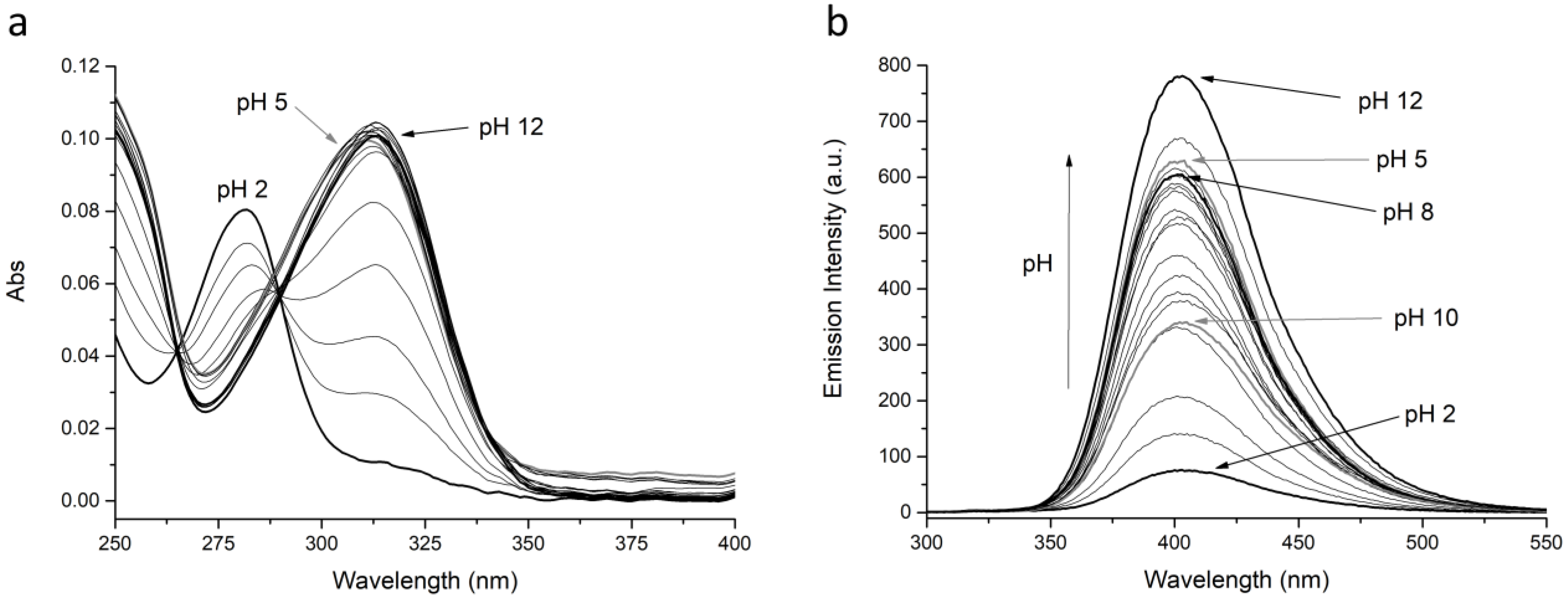
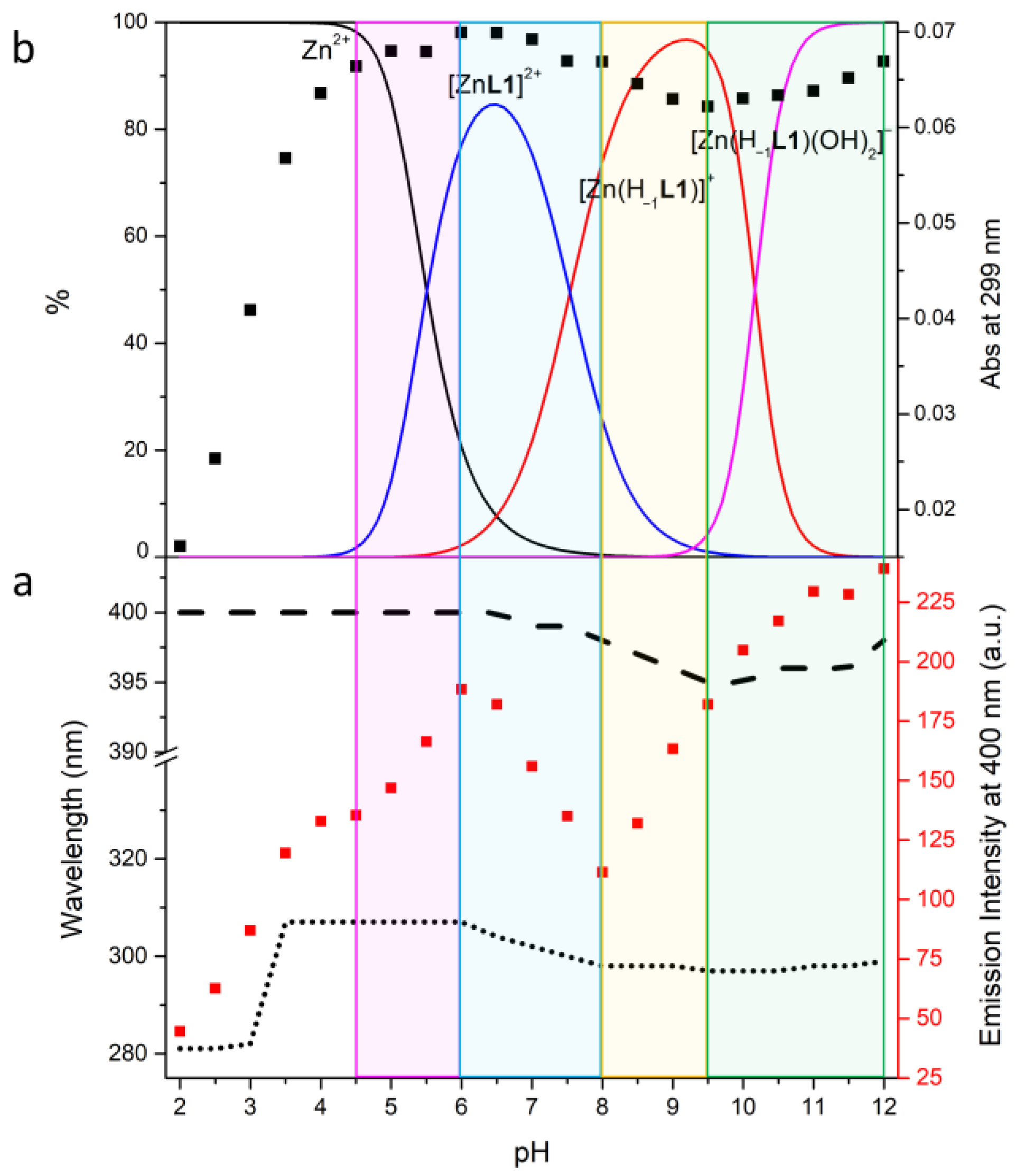
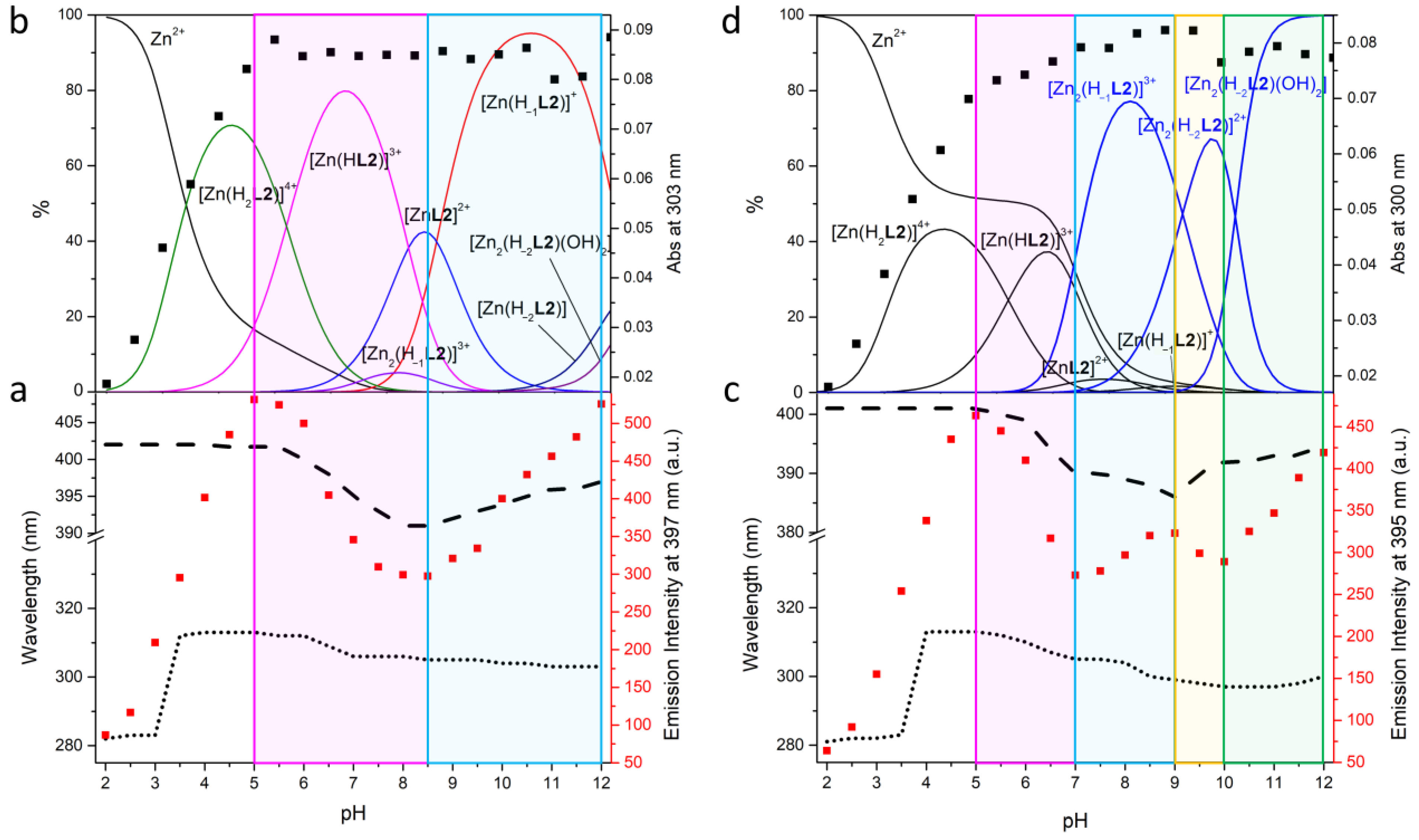
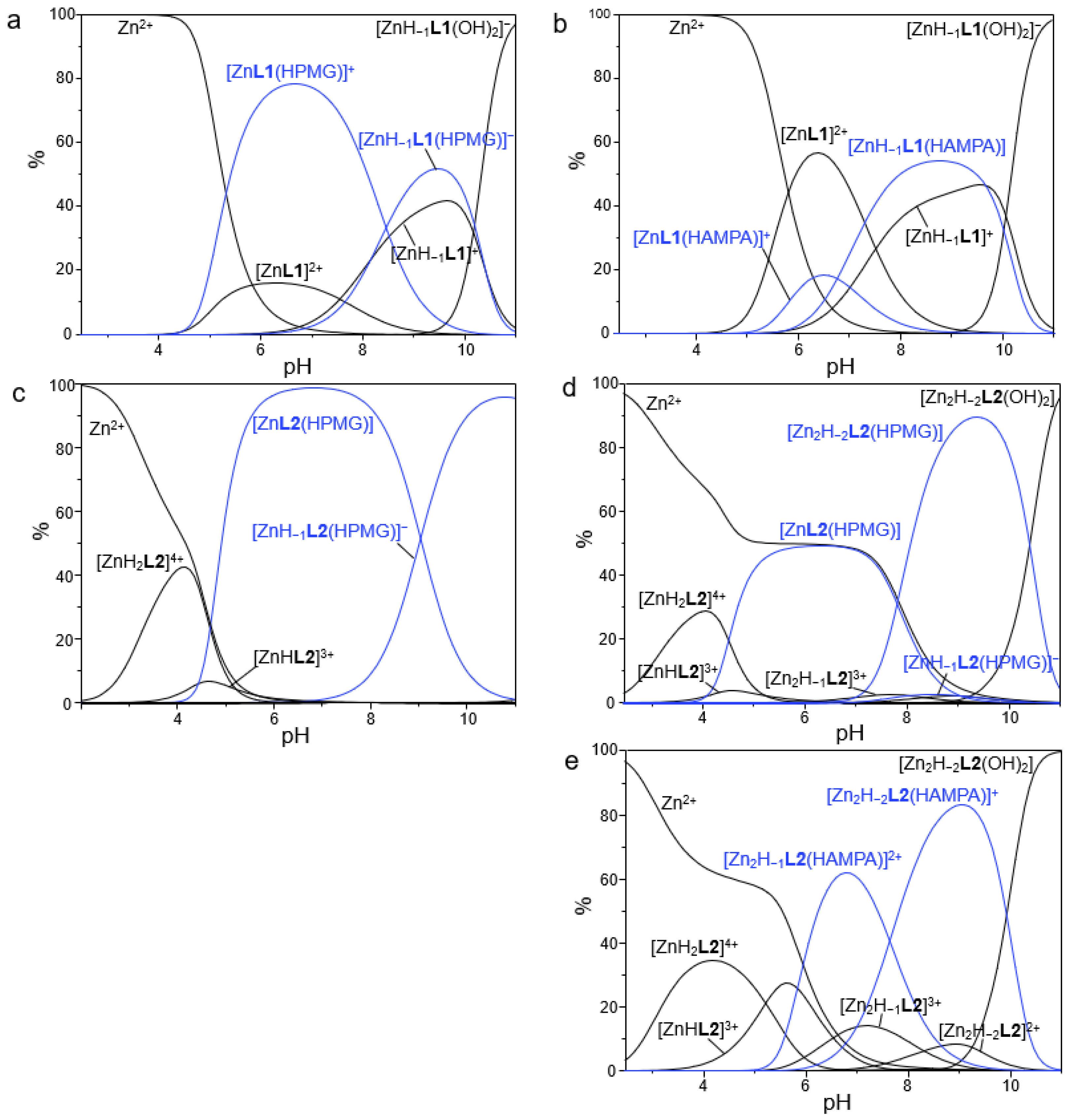

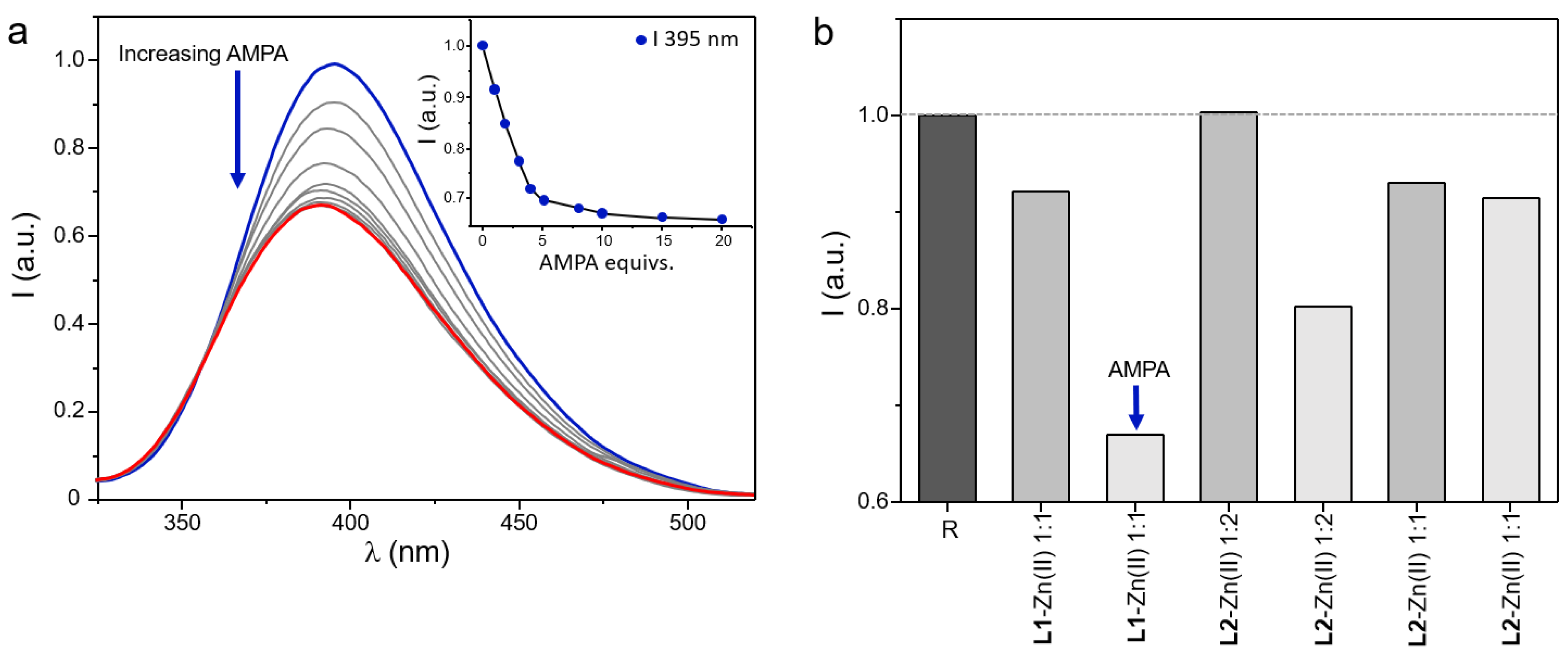
| Reaction | LogK | |
|---|---|---|
| L1 | L2 | |
| H−1L− + H+ = L | 10.34 (9) 1 | 10.22 (8) |
| L + H+ = HL+ | 10.14 (6) | 9.99 (8) |
| HL+ + H+ = H2L2+ | 6.89 (9) | 8.70 (9) |
| H2L2+ + H+ = H3L3+ | 3.60 (9) | 4.32 (8) |
| H3L3+ + H+ = H4L4+ | 2.28 (9) | 3.47 (8) |
| Reaction | LogK | |
|---|---|---|
| L1 | L2 | |
| H−1L− + Zn2+ = [Zn(H−1L)]+ | 12.14 (9) 1 | 12.98 (9) |
| [Zn(H−1L)]+ + H+ = [ZnL]2+ | 7.54 (8) | 7.89 (9) |
| L + Zn2+ = [ZnL]2+ | 9.54 (7) | 10.88 (8) |
| [ZnL]2+ + H+ = [Zn(HL)]3+ | - | 7.39 (8) |
| [Zn(HL)]3+ + H+ = [Zn(H2L)]4+ | - | 5.21 (7) |
| [Zn(H−1L)]+ + OH− = [Zn(H−1L)(OH)] | - | 2.44 (8) |
| [Zn(H−1L)]+ + 2OH− = [Zn(H−1L)(OH)2]− | 7.32 (8) | - |
| H−1L− + 2Zn2+ = [Zn2(H−1L)]3+ | - | 18.47 (8) |
| H−1L− + 2Zn2+ = [Zn2(H−2L)2+ + H+ | - | 10.16 (8) |
| [Zn(H−1L)]+ + Zn2+ = [Zn2(H−1L)]3+ | - | 5.49 (8) |
| [Zn2(H−2L)]2+ + 2OH− = [Zn2(H−2L)(OH)2] | - | 9.16 (7) |
| Reaction | L1 |
|---|---|
| LogK | |
| [Zn(H−1L1)]+ + HPMG2− = [Zn(H−1L1)(HPMG)]− | 3.54 (9) 1 |
| [ZnL1]2+ + HPMG2− = [ZnL1(HPMG)] | 4.46 (8) |
| [Zn(H−1L1)]+ + HAMPA− = [Zn(H−1L1)(HAMPA)] | 3.47 (9) |
| [ZnL1]2+ + HAMPA− = [ZnL1(HAMPA)]+ | 2.74 (8) |
| L2 | |
| LogK | |
| [Zn(H−1L2)]+ + HPMG2− = [Zn(H−1L2)(HPMG)]− | 6.97 (8) |
| [ZnL2]2+ + HPMG2− = [ZnL2(HPMG)] | 8.08 (9) |
| [Zn2(H−2L2)]2+ + HPMG2− = [Zn2(H−2L2)(HPMG)] | 5.97 (8) |
| [Zn2(H−1L2)]3+ + HAMPA− = [Zn2(H−1L2)(HAMPA)]2+ | 4.25 (8) |
| [Zn2(H−2L2)]2+ + HAMPA− = [Zn2(H−2L2)(HAMPA)]+ | 4.74 (7) |
Disclaimer/Publisher’s Note: The statements, opinions and data contained in all publications are solely those of the individual author(s) and contributor(s) and not of MDPI and/or the editor(s). MDPI and/or the editor(s) disclaim responsibility for any injury to people or property resulting from any ideas, methods, instructions or products referred to in the content. |
© 2023 by the authors. Licensee MDPI, Basel, Switzerland. This article is an open access article distributed under the terms and conditions of the Creative Commons Attribution (CC BY) license (https://creativecommons.org/licenses/by/4.0/).
Share and Cite
Giacomazzo, G.E.; Paderni, D.; Giorgi, L.; Formica, M.; Mari, L.; Montis, R.; Conti, L.; Macedi, E.; Valtancoli, B.; Giorgi, C.; et al. A New Family of Macrocyclic Polyamino Biphenolic Ligands: Acid-Base Study, Zn(II) Coordination and Glyphosate/AMPA Binding. Molecules 2023, 28, 2031. https://doi.org/10.3390/molecules28052031
Giacomazzo GE, Paderni D, Giorgi L, Formica M, Mari L, Montis R, Conti L, Macedi E, Valtancoli B, Giorgi C, et al. A New Family of Macrocyclic Polyamino Biphenolic Ligands: Acid-Base Study, Zn(II) Coordination and Glyphosate/AMPA Binding. Molecules. 2023; 28(5):2031. https://doi.org/10.3390/molecules28052031
Chicago/Turabian StyleGiacomazzo, Gina Elena, Daniele Paderni, Luca Giorgi, Mauro Formica, Lorenzo Mari, Riccardo Montis, Luca Conti, Eleonora Macedi, Barbara Valtancoli, Claudia Giorgi, and et al. 2023. "A New Family of Macrocyclic Polyamino Biphenolic Ligands: Acid-Base Study, Zn(II) Coordination and Glyphosate/AMPA Binding" Molecules 28, no. 5: 2031. https://doi.org/10.3390/molecules28052031
APA StyleGiacomazzo, G. E., Paderni, D., Giorgi, L., Formica, M., Mari, L., Montis, R., Conti, L., Macedi, E., Valtancoli, B., Giorgi, C., & Fusi, V. (2023). A New Family of Macrocyclic Polyamino Biphenolic Ligands: Acid-Base Study, Zn(II) Coordination and Glyphosate/AMPA Binding. Molecules, 28(5), 2031. https://doi.org/10.3390/molecules28052031













